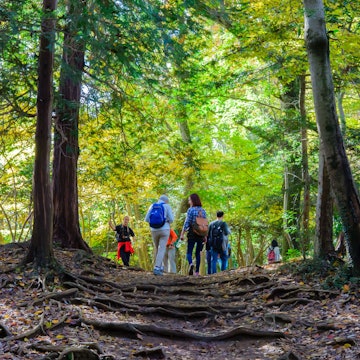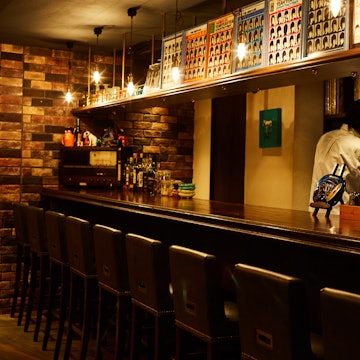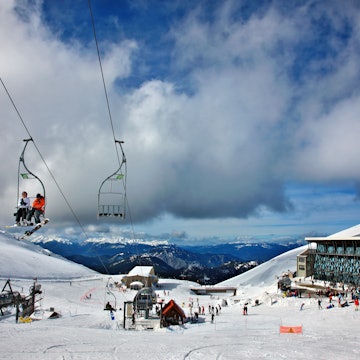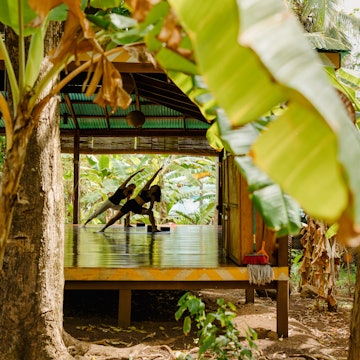
Discover Japan’s sustainable wonderland in Wakayama Prefecture

Apr 29, 2021 • 6 min read

Japan’s Wakayama Prefecture has long been revered for its natural and spiritual significance © Mirko Kuzmanovic / Shutterstock
Through the mists of time, Japan’s Wakayama Prefecture has been revered for its natural and spiritual significance. Here among the primeval forest, rejuvenating hot springs and breathtaking natural vistas of the Kii Peninsula, even the air itself feels sacred.
Traversing its ancient network of trails in pilgrimage connects one to not only places of worship, but also to the wider natural environment, where meditating to the rhythm of nature and the sound of one’s footsteps becomes a healing balm for the soul.
Sustainable travel has been intrinsic to visits to the area for thousands of years. Through showing great respect and humility to nature and the deities that dwell within it, pilgrims have long sought self-inquiry and salvation.
More recently, with the ‘Sacred Sites and Pilgrimage Routes in the Kii Mountain Range’ collectively named a UNESCO World Heritage Site, the region’s historically sustainable practices have been further solidified, managed and protected to ensure Wakayama’s continued preservation for visitors.
Whether you’re seeking connection with a higher power, nature, yourself or even other hikers – often known as dōgyō-ninin – here are just some of the ways to enjoy Wakayama’s bountiful natural offerings.
The Kumano Kodō
The Kumano Kodō is a 1100-year-old network of ancient coastal and mountainous pilgrimage routes that connect the “Kumano Sanzan” or the Three Grand Shrines and the temple of Kumano: Hongū Taisha, Nachi Taisha, Hayatama Taisha, and Seiganto-ji Temple.
Unlike some hikes that have one set start and end point, the Kumano Kodō’s varied and intersecting routes mean one can make this experience their own based on time, interest and level of physical fitness, from just a few hours on the trails to a multi-day pilgrimage.
The most popular and accessible to visitors is the mountainous Nakahechi Imperial Route between Takijiri-ōji and Nachi Taisha, where you literally walk in the footsteps of bygone Emperors, nobles and commoners. At around 70 kilometers (40 miles), the full course takes most hikers 4-5 days to complete, staying overnight at small minshuku (family-run inns) along the way.
The limited capacity of the accommodations is all part of the sustainable ethos of the Kumano Kodō, allowing nature and hikers the breathing room that makes a pilgrimage here so special.
If you yearn for time to contemplate or to not think at all, the unspoken and all-knowing energy that resides on these ancient pathways seems to deliver exactly what your heart and mind requires.
Saigoku 33 Temple Pilgrimage
The Saigoku 33 Temple Pilgrimage covers thirty-three temples (and three bangai, or extras) dedicated to Kannon, the Bodhisattva of Compassion, over an incredible seven prefectures – the first three in Wakayama.
The legend of its origin involves a monk called Tokudo who in the year 718 was apparently called upon by Enma-ō, overlord of hell, whose realm was filling up too fast, to establish a place of worship for each of the thirty-three incarnations of Kannon, so that those who traveled the route could be granted salvation.
The Wakayama section of the pilgrimage begins at Seiganto-ji Temple and ends at the impressive Kokawadera Temple, established in the year 770. The grand scale of Kokawadera’s hondō (main hall), rebuilt in the 18th Century, is a sight to behold and easily the largest on the entire pilgrimage.
The approach to the temple is flanked by the Kokawadera Teien rock garden. Assembled during the Momoyama period (1574-1602), this unusual rock garden is so unique it has been designated a National Scenic Beauty. Here you won’t find any of the minimalism of a typical zen garden, but an abundance of locally sourced rocks from Wakayama, arranged as a distinctive dry landscape garden.
If traveled sequentially, the Saigoku Pilgrimage covers a staggering 600 miles. Given the great distance, many people visit the temples over several trips (in any order) and have each visit stamped in a special book called a nōkyōchō. It is believed this practice goes back to the legend of Enma-ō, who apparently gave Tokudo thirty-three seals to verify his temple visits.
Kōyasan
Kōyasan is the most sacred site of Shingon Buddhism, a Buddhist sect that was introduced to Japan in 806 by Kōbō Daishi, a monk who received what is known as ‘the legitimacy of the teachings of esoteric Buddhism’ in China.
It is said from China he threw a sankosho (a three-pronged prayer tool) that landed in a pine tree on Kōyasan, which is why he decided to found the main training place for monks of Japan’s Shingon sect here in 816.
The small town, which is nestled among eight peaks that form the shape of Buddha’s lotus flower, is now home to approximately 100 temples, around half of which open their doors to visitors as shukubō or overnight temple lodgings. The shukubō provide a unique window into monastic life, with visitors given the opportunity to try shōjin ryōri, the Buddhism vegetarian cuisine, and participate in morning prayers.
Sustainable, seasonal vegetables and mountain-picked vegetables (sansai) are a common feature of the meals, and a temple stay a chance to slow down and reconnect with oneself and the natural world.
Not to be missed is a visit to Okunoin, home to Japan’s largest cemetery and the mausoleum of Kōbō Daishi, where it is believed he has not died, but is praying for the people in eternal meditation as he waits for Miroku Nyorai, the Buddha of the future.

Shirahama
Shirahama or ‘white beach’ is a hot spring town with a 650-meter (third of a mile) sand beach. First mention of the town’s onsen was recorded in 657 when Imperial Prince Arima stayed there, ranking it among Japan’s three oldest hot springs.
While Wakayama’s mountains have plenty of bathing opportunities, seaside onsen provide a whole different experience. A must-visit is Saki-no-yu, a rotenburo (outdoor bath) that merges with the Pacific Ocean.
Soak in the natural spring water as the spray from the waves and the salty sea air coalesce to create a harmonious cooling effect with the steaming baths.

Wakanoura
The scenic bay area of Wakanoura is so breathtaking it prompted a new art form.
As the first marine resort destination in Japan, royal and noble families from Nara would come to visit the ocean and see its grand scope. They would then be inspired to write ‘waka poetry’ to express the sensation of their first glimpse of the ocean, sending the poems back to their family and friends inland.
Ever since, poets have been inspired to capture Wakanoura’s constantly-changing beauty in words. Their earliest writings featured in the 1,300-year-old Man’yōshū, Japan’s oldest collection of poetry.
Visitors can get a panoramic view of the bay, and its disappearing and reappearing tidal flats, by climbing the 231 steps to Kimii-dera, founded in 770 and the second temple on the Saigoku Kannon Pilgrimage. It is believed the Goddess of Waka resides in the bay inspiring Man’yō era poets and Edo period painters alike.
A beacon of sustainability
At its heart, sustainability is a form of preservation — an apparatus designed to alleviate the environmental, economic and sociocultural pressures tourism places on a destination.
By that measure, Wakayama shines – its sightseeing destinations have continued in a sustainable manner since ancient times, bringing the great outdoors and its restorative qualities to pilgrims for thousands of years.
Conservancy springing from healing – a shining example for the world today.















